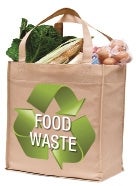Large institutions and food waste processors are preparing for new regulations that will require the separation of food waste from the primary waste stream beginning next summer.
Come July 1, Massachusetts is slated to become the first state to require organic food waste be taken to a composting or anaerobic digest facility rather than a landfill.
The law will apply to all institutions that generate more than one ton of waste per week, or about 1,700 hospitals, hotels, supermarkets and large restaurants across the commonwealth. Roughly 850 of these entities are already taking part of their food waste some place other than a landfill, said John Fischer, commercial waste recycling chief for the Massachusetts Department of Environmental Protection (DEP).
A steady stream of produce, dairy products and other food scraps will provide the capacity of raw materials needed to grow the composting and anaerobic digestion sectors, Fischer said. That’ll serve to slow the filling of landfills, for which 60 percent of their current holdings could be recycled or composted, said Steve Bandarra, the sustainability coordinator at Worcester State University.
Anaerobic digestion is a biological process that converts the methane gas found in organic food products into energy. By capturing the methane, anaerobic digestion prevents the gas from being released into the ozone layer.
Both anaerobic digestion and composting are sources of fertilizer, but only anaerobic digestion can feed the region’s electric grid, Fischer said.
Massachusetts wants to increase the energy generated from anaerobic digestion from five to 10 megawatts today to 50 megawatts by 2020, Fischer said. And to complement that by reducing the amount of food waste taken to landfills each year from one million tons to 650,000 tons by 2020.
The ban is expected to reduce the amount of food waste going to landfills by 200,000 tons, Fischer said, with the commonwealth seeking other ways to divert 150,000 tons of food waste over the next several years.
Industry Groups: OK With Us
Neither supermarkets nor restaurants expect the ban to disrupt business, according to the trade organizations that represent them.
Restaurants or supermarkets with at least 35 full-time employees are usually the only facilities large enough to generate at least one ton of waste weekly, according to the DEP. That level of waste would usually come only from buffet-style restaurants with a couple hundred seats, said Stephen Clark, director of government affairs for the Massachusetts Restaurant Association, based in Southborough.
“We don’t see the regulations having a huge impact on us,” he said.
The Massachusetts Food Association signed an agreement with the state in 2005 that provides regulatory relief to supermarkets willing to send their food waste to someplace other than a landfill, said Brian Houghton, the association’s vice president.
Therefore, more than 300 of the commonwealth’s 600 supermarkets are already diverting their food waste from landfills, Houghton said. Many of the supermarkets that don’t are smaller, Houghton said, and therefore wouldn’t be subject to the new requirements.
“It’s a good business practice as well as good for the environment,” he said.
Hauling food scraps to a composter or anaerobic digester costs just $40 to $50 per ton, well below the $60 to $70 per-ton fee to bring trash to a landfill, Fischer said.
Worcester State University began bringing a half ton of food waste each week to a composting facility at the start of 2013, Bandarra said, costing the school $110 each year, he said.
Central Massachusetts is home to the prototype for anaerobic digestion. The first anaerobic digester in the commonwealth was installed in 2011 on 1.5 acres on Jordan Dairy Farms in Rutland.
The farm accepts 40 tons of food waste each year, said Bill Jorgenson, managing partner of AGreen Energy LLC, which runs the digester. The system runs on a mix of 60 percent food waste and 40 percent manure, Jorgenson said, with the addition of the waste tripling the energy potential.
Using a 300-kilowatt engine, 225 million kilowatts of energy are produced per year, Jorgenson said. And the resulting fertilizer has no odor, said farm owner Randy Jordan.
Some 15 percent of that electricity is used to power the farm, Jorgenson said, while the remainder is sold back to the grid for roughly $500,000 each year.
The digester saves the farm several thousand dollars a year in electricity costs, Jordan said. And AGreen earns a 10- to 12-percent profit each year from the operation, Jorgenson said.
AGreen plans to upgrade to a 500-kilowatt digester engine over the winter, which will allow for the generation of 350 million kilowatts of energy.
The larger engine means the farm should be able to stop having to burn off excess gas at the digester, Jordan said.
“We’re just wasting gas that could be used to make energy,” he said.

